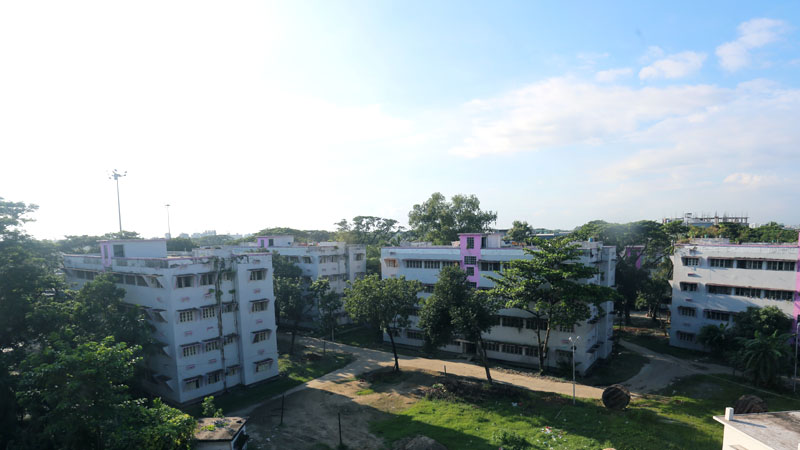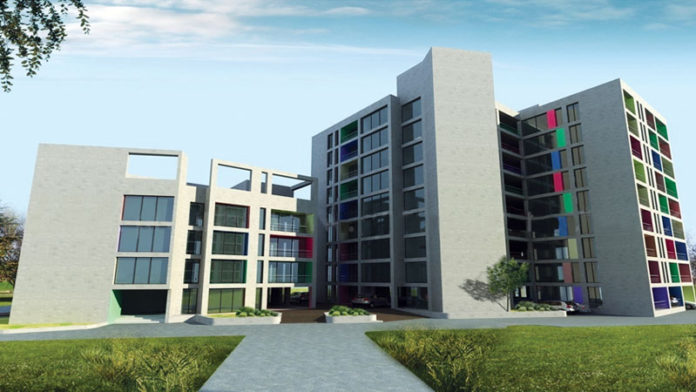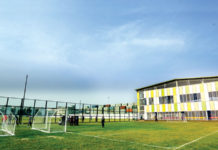Success of Chittagong port is subject to the capacity and wellbeing of its officers and the staff, which is an issue of extreme importance to the port authority. Since past, it has been striving to provide all the related supports, like, education, health and housing for its human resource. Nevertheless, it also offers regular incentives to its workers for timely motivation. In addition, it provides furnished residence, hospital facility, schools and colleges, clubs, playing fields, bazars and places to worship for the community.
Home for all
The authority took to providing residence facilities to its workers as much earlier as the British era. The Bandar Bhaban was shifted from Sadar Ghat to its current location during the final days of Pakistani administration (1965-66). Buildings began to rise up near the Bandar Bhaban within the High School Colony and the North and South residential areas. During those early days, port used to be run by the rail-port trust and as a consequence many of the residences were built on lands that fell within their jurisdiction. In later years, this became a matter of dispute between the two when port and railway bond was ultimately discarded.
During the mid-sixties, the fourth class employees of the port developed a colony all on their own initiative, near the Maheshkhal Bridge area next to the Chittagong Container Terminal (CCT), which in due course became known as ‘Dhaka Colony’. They had built their own shanty huts there. However, the colony transferred to a different location when the construction work of the Container Terminal commenced in the 1980s.
Residences that stood nearby the jetties were also relocated to a little distance for facilitating room for the port’s expansion. A total of 57 houses were demolished in the area during the 1990s when the authority began the construction of New Mooring Container Terminal. The largest residential facility known as the ‘Labor Colony’ abolished with the abolition of the Dock Laborer Management Board. All registered workers were later incorporated alongside the promulgation of the gazette ordnance in 2008.
Port operation gained real momentum after the independence of the country. Development of the port became the focal point for its leaders and the policy makers. As part of an earlier plan, 3-4 buildings were raised within the premises of High School Colony. Eventually, initiatives got underway for the allocation of residences for the port officers and staff of different tiers. All the housing facilities are equipped with services like, residence, sewerage, road communication, street lights, playing fields and parks for leisure and recreation. The residential areas are well-connected to the bazars and the hospitals. Twenty four hour water supply and electricity have been ensured at all the buildings of the locality.
At present, the older buildings are being demolished and then reconstructed into buildings with modern amenities over short and long term schemes. All the habitats lie within 2 kilometers from the port premises facilitating the staff to attend the job without commuter complexities. Engineering department of the port actually implement these tasks of building, repairing and allotting the buildings to the authorized person, following a predefined housing policy. Accordingly, A, B, C and D type buildings are allotted to the general staff, D type for the 2nd class workers and E and F type buildings are reserved for the 1st class officers. Bungalows are allotted to the Chairman of the port authority, the board members, directors, departmental heads and their deputies. Dormitory facilities are provided for the bachelor staff. Improved water supply and sewerage, waste management and security is ensured at all the housings irrespective of their status and class.
Healthcare for all
In earlier days, the port had no hospital of its own. The staff had to go to the railway hospital for their health related issues. Initially, a dispensary was installed at the Port Commissioner’s office near Sadar Ghat for the health care of the port staff. Afterward, a 12-bed hospital emerged in 1962 with indoor facility at the current site of the police line, next to the port stadium. Providing health service commenced through the outdoor treatment facilities from the hospital. The hospital up graded to 30 beds in 1965 and 70 beds in 1967. In 1965, the India-Pakistan war brought a temporary closure to all the development works happening in the country and the hospital too fell victim to this. The H-shaped structure was elevated on a 5-acre land to the west face of Bandar Bhaban which was further up graded to 150 beds in 1984. The health care service expanded keeping up with the growing number of port staff. Health Care Hospital for the Laborers was built in 1980 along with the formation of the Dock Laborer Management Board. After a brief closure, this Health Care Hospital emerged in a different shape at Jetty Gate No.3 since 2011. Construction work of a 4-storey modern hospital complex outstretched in 5 blocks is currently underway. Completion of the project will elevate the health care service to a whole new level.

Chittagong Port Hospital offers both indoor and outdoor health services. It has medicine, surgery, dental, ocular, gynecology and ENT departments. To ensure health service round the clock 27 doctors are working under the auspices of the Chief Medical Officer. For male patients it has medical and surgical wards while for females, it has gynecology ward and a few cabins. Patients can avail treatments for Thalassemia, tuberculosis, kidney dialysis, blood transplantation in addition to physiotherapy for the paralyzed and the cancer patients. The center has provisions for vaccination programs e.g. hepatitis B and uterus cancer. It has state-of-the-art Operation Theater for any kind of benign or complicated operation which is supported by a panel of experienced doctors and anesthetists. The hospital has its own diagnostic facilities for the detection of diseases and issues. In addition, there is also a small-scale coronary unit for the cardiac patients.
Anyone can have health care service from the hospital. All he has to do is entry his name at the ticket counter at the outdoor, and then he would be sent to the appropriate doctor. Doctors are available 24 hours a day at the emergency department. On average, 600-700 patients are getting health care service from the outdoor while 100-150 patients from the indoor regularly.
All treatment and medicines are free for the port staff be it indoor or the outdoor at the port hospital. Any diagnostic test or examinations which is not available at the hospital at present, are done from the external private facilities. The hospital authority bears the burden of this cost. All medicines are also provided from the store as per the prescription of the doctors.
The hospital has a 24-hour ambulance service for emergencies, like carrying the victim of an accident or transporting critical patients to the hospital. There is also an ambulance ship adorned with modern treatment facilities for providing health service to the sailors on board of ships anchored at the port.
Port hospital is the center of health care service for the port. As number of staff of the port is increasing, so is expanding the service areas needed to address the health related issues. Building of the 4-storey building is almost near its completion. Once built, the authority will launch the CCU and ICU at the complex. There is also a discourse for enhancing the hospital’s capacity up to 200-beds within the shortest possible time.



